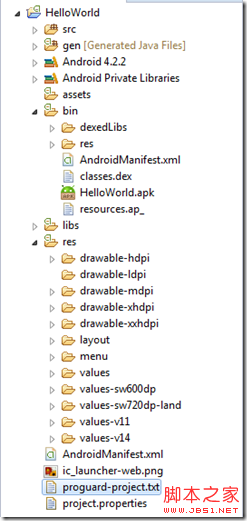編輯:Android開發實例
Android獲取系統cpu信息,內存,版本,電量等信息 1、CPU頻率,CPU信息:/proc/cpuinfo和/proc/stat
通過讀取文件/proc/cpuinfo系統CPU的類型等多種信息。
讀取/proc/stat 所有CPU活動的信息來計算CPU使用率
下面我們就來講講如何通過代碼來獲取CPU頻率:
代碼如下:
package com.orange.cpu;
import java.io.BufferedReader;
import java.io.FileNotFoundException;
import java.io.FileReader;
import java.io.IOException;
import java.io.InputStream;
public class CpuManager {
// 獲取CPU最大頻率(單位KHZ)
// "/system/bin/cat" 命令行
// "/sys/devices/system/cpu/cpu0/cpufreq/cpuinfo_max_freq" 存儲最大頻率的文件的路徑
public static String getMaxCpuFreq() {
String result = "";
ProcessBuilder cmd;
try {
String[] args = { "/system/bin/cat",
"/sys/devices/system/cpu/cpu0/cpufreq/cpuinfo_max_freq" };
cmd = new ProcessBuilder(args);
Process process = cmd.start();
InputStream in = process.getInputStream();
byte[] re = new byte[24];
while (in.read(re) != -1) {
result = result + new String(re);
}
in.close();
} catch (IOException ex) {
ex.printStackTrace();
result = "N/A";
}
return result.trim();
}
// 獲取CPU最小頻率(單位KHZ)
public static String getMinCpuFreq() {
String result = "";
ProcessBuilder cmd;
try {
String[] args = { "/system/bin/cat",
"/sys/devices/system/cpu/cpu0/cpufreq/cpuinfo_min_freq" };
cmd = new ProcessBuilder(args);
Process process = cmd.start();
InputStream in = process.getInputStream();
byte[] re = new byte[24];
while (in.read(re) != -1) {
result = result + new String(re);
}
in.close();
} catch (IOException ex) {
ex.printStackTrace();
result = "N/A";
}
return result.trim();
}
// 實時獲取CPU當前頻率(單位KHZ)
public static String getCurCpuFreq() {
String result = "N/A";
try {
FileReader fr = new FileReader(
"/sys/devices/system/cpu/cpu0/cpufreq/scaling_cur_freq");
BufferedReader br = new BufferedReader(fr);
String text = br.readLine();
result = text.trim();
} catch (FileNotFoundException e) {
e.printStackTrace();
} catch (IOException e) {
e.printStackTrace();
}
return result;
}
// 獲取CPU名字
public static String getCpuName() {
try {
FileReader fr = new FileReader("/proc/cpuinfo");
BufferedReader br = new BufferedReader(fr);
String text = br.readLine();
String[] array = text.split(":\\s+", 2);
for (int i = 0; i < array.length; i++) {
}
return array[1];
} catch (FileNotFoundException e) {
e.printStackTrace();
} catch (IOException e) {
e.printStackTrace();
}
return null;
}
}
2、內存:/proc/meminfo
代碼如下:
public void getTotalMemory() {
String str1 = "/proc/meminfo";
String str2="";
try {
FileReader fr = new FileReader(str1);
BufferedReader localBufferedReader = new BufferedReader(fr, 8192);
while ((str2 = localBufferedReader.readLine()) != null) {
Log.i(TAG, "---" + str2);
}
} catch (IOException e) {
}
}
3、Rom大小
代碼如下:
public long[] getRomMemroy() {
long[] romInfo = new long[2];
//Total rom memory
romInfo[0] = getTotalInternalMemorySize();
//Available rom memory
File path = Environment.getDataDirectory();
StatFs stat = new StatFs(path.getPath());
long blockSize = stat.getBlockSize();
long availableBlocks = stat.getAvailableBlocks();
romInfo[1] = blockSize * availableBlocks;
getVersion();
return romInfo;
}
public long getTotalInternalMemorySize() {
File path = Environment.getDataDirectory();
StatFs stat = new StatFs(path.getPath());
long blockSize = stat.getBlockSize();
long totalBlocks = stat.getBlockCount();
return totalBlocks * blockSize;
}
4、sdCard大小
代碼如下:
public long[] getSDCardMemory() {
long[] sdCardInfo=new long[2];
String state = Environment.getExternalStorageState();
if (Environment.MEDIA_MOUNTED.equals(state)) {
File sdcardDir = Environment.getExternalStorageDirectory();
StatFs sf = new StatFs(sdcardDir.getPath());
long bSize = sf.getBlockSize();
long bCount = sf.getBlockCount();
long availBlocks = sf.getAvailableBlocks();
sdCardInfo[0] = bSize * bCount;//總大小
sdCardInfo[1] = bSize * availBlocks;//可用大小
}
return sdCardInfo;
}
5、電池電量
代碼如下:
private BroadcastReceiver batteryReceiver=new BroadcastReceiver(){
@Override
public void onReceive(Context context, Intent intent) {
int level = intent.getIntExtra("level", 0);
// level加%就是當前電量了
}
};
registerReceiver(batteryReceiver, new IntentFilter(Intent.ACTION_BATTERY_CHANGED));
6、系統的版本信息
代碼如下:
public String[] getVersion(){
String[] version={"null","null","null","null"};
String str1 = "/proc/version";
String str2;
String[] arrayOfString;
try {
FileReader localFileReader = new FileReader(str1);
BufferedReader localBufferedReader = new BufferedReader(
localFileReader, 8192);
str2 = localBufferedReader.readLine();
arrayOfString = str2.split("\\s+");
version[0]=arrayOfString[2];//KernelVersion
localBufferedReader.close();
} catch (IOException e) {
}
version[1] = Build.VERSION.RELEASE;// firmware version
version[2]=Build.MODEL;//model
version[3]=Build.DISPLAY;//system version
return version;
}
7、mac地址和開機時間
代碼如下:
public String[] getOtherInfo(){
String[] other={"null","null"};
WifiManager wifiManager = (WifiManager) mContext.getSystemService(Context.WIFI_SERVICE);
WifiInfo wifiInfo = wifiManager.getConnectionInfo();
if(wifiInfo.getMacAddress()!=null){
other[0]=wifiInfo.getMacAddress();
} else {
other[0] = "Fail";
}
other[1] = getTimes();
return other;
}
private String getTimes() {
long ut = SystemClock.elapsedRealtime() / 1000;
if (ut == 0) {
ut = 1;
}
int m = (int) ((ut / 60) % 60);
int h = (int) ((ut / 3600));
return h + " " + mContext.getString(R.string.info_times_hour) + m + " "
+ mContext.getString(R.string.info_times_minute);
}
 Android 初識 Helloworld 詳解
Android 初識 Helloworld 詳解
HelloWorld的目錄結構有: src:存放應用程序的邏輯代碼,這裡面的代碼是人工寫的gen:存放資源代碼,這裡面的代碼是自動生成的assets:存放mp
 Android加載Spinner
Android加載Spinner
可以顯示在的Android任務,通過加載進度條的進展。進度條有兩種形狀。加載欄和加載微調(spinner)。在本章中,我們將討論微調(spinner)。Spinner 用
 Android本地化
Android本地化
Android應用程序可以在許多不同地區的許多設備上運行。為了使應用程序更具交互性,應用程序應該處理以適合應用程序將要使用的語言環境方面的文字,數字,文件等。在本章中,我
 Android JSON解析器
Android JSON解析器
JSON代表JavaScript對象符號。它是一個獨立的數據交換格式,是XML的最佳替代品。本章介紹了如何解析JSON文件,並從中提取所需的信息。Android提供了四個